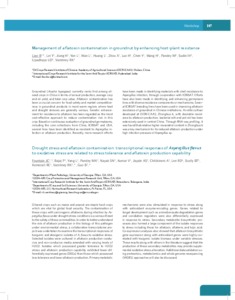Drought stress and aflatoxin contamination: transcriptional responses of Aspergillus flavus to oxidative stress are related to stress tolerance and aflatoxin production capability
Abstract
Oilseed crops such as maize and peanut are staple food crops which are vital for global food security. The contamination of these crops with carcinogenic aflatoxins during infection by Aspergillus flavus under drought stress conditions is a serious threat to the safety of these commodities. In order to better understand the role of aflatoxin production in the biology of this pathogen under environmental stress, a collaborative transcriptome project was undertaken to examine the transcriptional responses of toxigenic and atoxigenic isolates of A. flavus to oxidative stress. Selected isolates were cultured in aflatoxin production-conducive and non-conducive media amended with varying levels of H2O2. Isolates which possessed greater tolerance to H2O2 stress and aflatoxin production capability exhibited fewer differentially expressed genes (DEGs) than those which possessed less tolerance and lower aflatoxin production. Primary metabolic mechanisms were also stimulated in response to stress along with antioxidant enzyme-encoding genes. Genes related to fungal development such as aminobenzoate degradation genes and conidiation regulators were also differentially expressed in response to stress. Secondary metabolite biosynthetic processes also formed a large component of the isolate responses to stress including those for aflatoxin, aflatrem, and kojic acid. Co-expression analyses also showed that aflatoxin biosynthetic gene expression along with antioxidant genes were highly correlated with toxigenic isolate biomass under variable stresses. These results along with others in the literature suggest that the production of these secondary metabolites may provide supplemental oxidative stress alleviation. Additional data validation using proteomics, metabolomics and whole genome resequencing (WGRS) approaches will also be discussed

